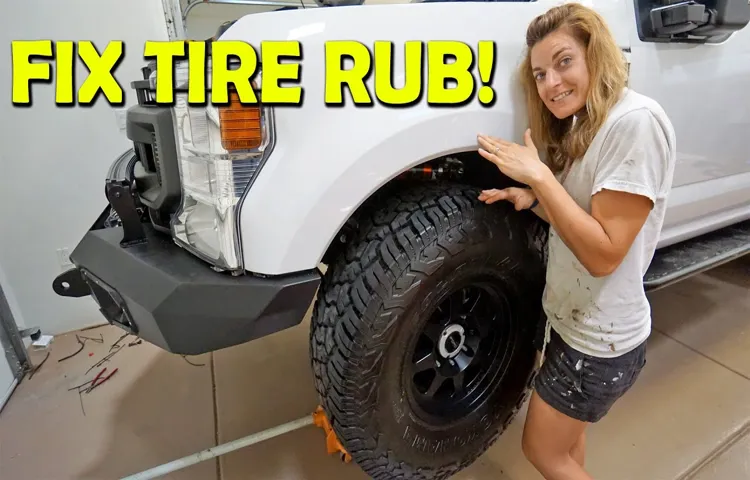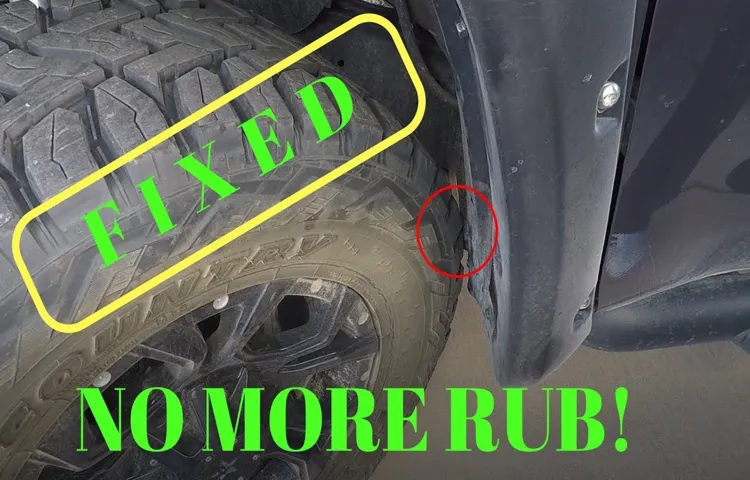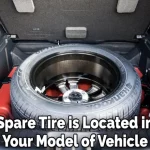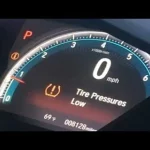Are you tired of hearing the annoying sound of your truck tires rubbing against the wheel well? Do you want to fix this problem quickly and easily? If so, you’re in luck because we’ve got all the tips and tricks you need to get rid of this pesky issue! Tire rubbing is a common problem among truck owners, and it’s easy to understand why. With heavy loads and rough terrain, it’s not uncommon for tires to rub against the wheel well, causing noise and potentially damaging the tire. However, this issue can be resolved with a few simple adjustments and techniques.
In this blog post, we’ll walk you through the steps to fix tire rubbing on your truck. From adjusting tire pressure to installing wheel spacers, we’ll cover all the methods to ensure your truck tires run smoothly and quietly. Plus, we’ll share some tips on how to prevent tire rubbing from happening in the future, saving you time and money in the long run.
So, if you’re ready to say goodbye to tire rubbing and hello to a more comfortable and efficient driving experience, keep reading. We’ve got all the information you need to fix this issue once and for all.
Table of Contents
Identifying the Cause of Tire Rubbing
If you’re experiencing tire rubbing on your truck, the first step is to identify the cause of the problem. Common causes include worn suspension components, incorrect wheel offset, and oversized tires. One way to diagnose the issue is to inspect the tires and wheels for any signs of wear or damage.
Another option is to take your truck to a qualified mechanic who can perform a thorough inspection and provide recommendations for fixing the issue. Once you identify the cause of the rubbing, there are several possible solutions, including adjusting the suspension, changing the wheel offset, or installing smaller tires. It’s important to address the issue promptly to prevent further damage and ensure optimal vehicle performance.
With the right approach and the help of a professional, you can fix tire rubbing on your truck and enjoy smooth, safe driving.
Check for Misaligned Wheels
If you’re hearing a strange rubbing sound coming from your tires, there’s a good chance that they are misaligned. Misaligned wheels can cause your tires to wear out more quickly than they should, and can even decrease your fuel efficiency. The good news is that identifying the cause of tire rubbing isn’t too difficult.
In most cases, a visual inspection of your tires and wheels can reveal whether they are aligned or not. If you notice that the tires are not sitting evenly on the ground, this can be a sign of misalignment. Another sign to look out for is if your car pulls to one side or the other when you’re driving.
If you notice any of these signs, it’s probably time to take your car to a mechanic. A professional can help you realign your wheels and get your car back to driving smoothly on the road. By taking care of your tires, you can ensure that your car is safe, reliable, and efficient whenever you’re out on the road.

Check for Worn Out Suspension Components
“tire rubbing” If you notice tire rubbing while driving, it can be a sign of a larger issue with your vehicle’s suspension components. The first step is to identify the cause of the rubbing. It could be due to worn out suspension components, including springs, struts, or shocks.
You may also want to check for any loose or damaged parts that could be causing the issue. A professional inspection can help pinpoint the exact cause of the rubbing, ensuring that your vehicle is safe and operating smoothly. Keeping your suspension components in good repair ensures a smooth ride and prevents tire damage, both of which are essential for maintaining your vehicle’s longevity.
Adjusting the Suspension
If you’re experiencing tire rubbing on your truck, the first thing to check is the suspension. A misaligned or worn-out suspension can cause the tires to rub against the fender or other parts of the truck. The first step to fixing this issue is to inspect all the suspension components, including the shocks, springs, and control arms.
If any of these parts are worn out or damaged, they will need to be replaced. Once the suspension is in good working order, you can adjust it to prevent the tires from rubbing. Adjusting the suspension involves changing the ride height, camber, and toe.
It’s important to do this carefully, making small adjustments at a time until the tire rubbing stops. Keep in mind that adjusting the suspension can affect the handling and stability of your truck, so it’s best to consult a professional mechanic if you’re not comfortable doing this yourself. By properly adjusting the suspension, you can ensure that your tires aren’t damaged and that your truck rides smoothly and safely.
Adjust the Camber and Toe Settings
Adjusting the suspension of your vehicle is an essential part of its maintenance. One crucial component of the suspension system is the camber and toe settings, which can affect tire wear, handling, and overall vehicle performance. Camber refers to the angle of the wheels concerning the pavement, while toe measures the distance between the front and rear of the tires.
Over time, these settings can become misaligned due to wear and tear or driving on rough terrain. Adjusting these settings can improve vehicle stability, reduce tire wear, and improve handling. It’s crucial to have a trained professional adjust these settings as improper adjustments can cause further damage to your vehicle.
Regular suspension inspections and adjustments can significantly extend the lifespan of your vehicle and ensure optimal performance on the road. So, don’t ignore the suspension system; give it the attention it deserves, and your vehicle will thank you for it.
Install Spacers or Lift Kit
Adjusting the suspension of your vehicle can have a huge impact on its overall performance. One popular method to adjust the suspension is to install spacers or a lift kit. Spacers are added to the spring or strut assembly to increase the distance between the wheel and the hub, resulting in additional ground clearance.
On the other hand, lift kits increase the height of the entire vehicle by replacing the existing suspension components with larger ones. This can provide a more rugged and aggressive appearance while also allowing for greater off-road capabilities. However, it’s important to note that these modifications can affect the handling and stability of your vehicle, so it’s crucial to consult with a professional before making any changes.
With the right adjustments, your vehicle’s suspension can drastically improve its performance and appearance on and off the road.
Replacing Tires or Wheels
Are you experiencing tire rubbing on your truck and wondering what to do? One solution is to replace your tires or wheels. This can be an easy fix that can prevent further damage to your vehicle. First, make sure to determine which tire or wheel is causing the rubbing and inspect it for any visible damage.
If the damage is extensive, it may be necessary to replace the entire tire or wheel. However, if the damage is minimal, you may be able to simply replace the tire tread or realign the wheel. Remember to also check the size and type of tire or wheel that is recommended for your truck to ensure it runs smoothly and safely.
By replacing your tires or wheels, you can avoid future issues with tire rubbing and prolong the lifespan of your vehicle.
Choose Tires of the Correct Size and Offset
When replacing tires or wheels, it’s essential to choose the correct size and offset. The size of the tire refers to the width and height of the tire, while the offset is the distance between the center of the wheel and its mounting surface. Choosing the wrong size or offset can cause problems with your vehicle’s performance, handling, and safety.
For instance, if you install tires that are too big, they may rub against the fenders or suspension, causing damage. On the other hand, if you install tires that are too small, they won’t fit properly and could affect your vehicle’s handling. Similarly, the offset can affect your vehicle’s steering stability, as well as its braking and acceleration performance.
Therefore, it’s crucial to consult with a professional mechanic or tire expert to ensure you choose the right size and offset for your vehicle’s make and model. By doing this, you can reduce the risk of potential problems down the road.
Replace Worn Out or Damaged Tires and Wheels
Replacing Tires or Wheels One of the most common car problems we face is worn out or damaged tires, though it’s easy to overlook the significance of having the right tires and wheels. It can be tempting to ignore minor problems, hoping they’ll magically resolve on their own, but this might lead to significant damages. Worn out or damaged tires can cause deflation, resulting in poor control on the road, which might be dangerous, even fatal.
Replacing your tires or wheels regularly is essential for your safety and the safety of your passengers. It can also greatly improve the performance and fuel efficiency of your vehicle. So, don’t delay when it comes to replacing worn out or damaged tires or wheels! Instead, consider reaching out to trusted professionals to help you evaluate the best options according to your car’s make and model.
This investment is worthwhile and can help you avoid costly repairs in the future. Remember, your tires and wheels are the only contact your car has with the road, so maintaining them should be a top priority.
Preventing Future Tire Rubbing Issues
If you are experiencing tire rubbing issues with your truck, there are a few steps you can take to prevent this problem from occurring in the future. The first step is to ensure that your tires fit correctly on your truck and are properly aligned. Having the wrong size or type of tire can cause rubbing, so make sure you have the correct specs for your vehicle.
Another solution is to adjust the suspension on your truck, which can help to prevent rubbing by ensuring that the tires are correctly positioned. You can also invest in wheel spacers or fender flares to create more space between your tires and the body of the truck, which can help reduce the likelihood of rubbing. By being proactive and taking these steps, you can prevent future tire rubbing issues and have a smoother, more enjoyable driving experience.
So, next time you are facing tire rubbing on your truck, remember to take these simple prevention measures to avoid any future inconvenience.
Regularly Check the Suspension Components
One of the most crucial things you can do to prevent tire rubbing issues is to regularly check your suspension components. Your suspension system is responsible for keeping your tires in contact with the road, and if it’s damaged or worn, it can cause your wheels to tilt or wobble, resulting in tire rubbing. To avoid this problem, it’s essential to inspect your suspension regularly.
Look out for any signs of wear or damage, such as sagging or leaking shock absorbers, broken or cracked control arms or links, and loose or damaged ball joints. If you notice any of these issues, it’s important to have them repaired or replaced as soon as possible to prevent further damage and costly tire rub issues down the line. By keeping an eye on your suspension system, you’ll be able to catch any issues before they become major problems that could lead to tire damage or worse yet, an accident on the road.
Avoid Overloading Your Truck or Driving on Rough Terrain
When it comes to preventing future tire rubbing issues on your truck, it’s important to take a proactive approach. One of the most common causes of tire rubbing is overloading your truck. This can put too much weight on the tires and cause them to rub against the fenders.
To avoid this, make sure to never exceed the weight limit of your truck and distribute weight evenly throughout the bed. Another cause of tire rubbing is driving on rough terrain. While it may be tempting to take your truck off-road, it can cause damage to the tires and suspension system, leading to rubbing issues down the line.
If you do take your truck off-road, be sure to drive cautiously and avoid rough terrain whenever possible. By taking these preventative measures, you can help ensure your tires stay in good condition and avoid the frustration of tire rubbing issues in the future.
Conclusion
Well folks, if you’re dealing with pesky tire rubbing on your truck, fear not! With a little bit of elbow grease and some handy tools, you can easily fix the problem and get back on the road in no time. Remember to check your tire size, adjust your suspension if needed, and use spacers or wheel offsets if necessary. And if all else fails, just remember this wise advice from a famous mechanic: ‘If it ain’t broke, keep fixin’ it until it is.
‘”
FAQs
What causes tire rubbing on a truck?
Tire rubbing on a truck can be caused by a variety of reasons, such as worn-out suspension, incorrect tire size, damaged bearings, or misaligned wheels.
How can I fix tire rubbing on my truck?
To fix tire rubbing on your truck, you can check and adjust the tire’s air pressure, replace damaged suspension parts, use spacers or wheel adapters, or get a professional wheel alignment.
Is it safe to drive with tire rubbing on my truck?
No, it is not safe to drive with tire rubbing on your truck. It can cause damage to your vehicle’s tires, wheels, and suspension, which can result in reduced performance and safety risks.
How much does it cost to fix tire rubbing on a truck?
The cost to fix tire rubbing on a truck can vary depending on the specific issue. It can range from a few hundred dollars for basic repairs to several thousand dollars for more complex issues.
Can tire rubbing damage my truck’s body?
Yes, tire rubbing on your truck can damage its body, especially if it happens frequently or for a prolonged period. It can cause scratches, dents, or wear on the paint or body panels.
How often should I check my truck’s suspension for tire rubbing?
It is recommended to check your truck’s suspension for tire rubbing at least once a year or whenever you notice unusual noises or vibrations while driving.
Can I fix tire rubbing on my truck myself, or should I take it to a professional?
It depends on the severity and complexity of the issue. If it’s a simple adjustment like checking the air pressure or using spacers, you can do it yourself. However, for more significant repairs or replacements, it’s best to seek professional help.



